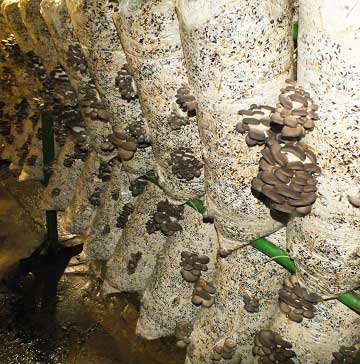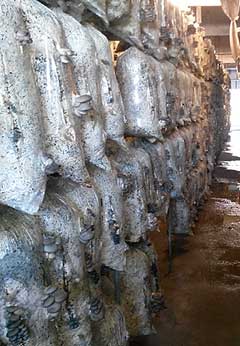
Table of Contents
When the mycelium is ready to bear fruit, it forms primordia, from which single mushrooms or mushroom clusters grow (depending on the mushroom species). This is called the "first flush".
After the mushrooms have harvested or produced spores (in nature), the mycelium rests and recovers. There are no mushrooms. After resting, the mycelium again forms primordia and the mushrooms grow. This is the "second flush".
In Ukraine, we call it "waves", not "flush". It is very similar to the fact that a wave first appears near the shore, and then it disappears, and after a while it comes again. Just like mushrooms!
Be sure to inspect the slits: if white dense pieces of mushroom tissue stick out of the substrate, they must be carefully cleaned.
The holes are processed after collecting oyster mushrooms so that the mycelium can grow faster to the perforations. And so that mold does not settle on the remains of the mushroom butt.
You do not need to make new slits for the second harvest, the mycelium will grow into the same holes.
You only need to remove the compacted white lump. It is advisable to do this operation immediately during the collection of bunches. If you are in a hurry to collect and distribute the goods to retail outlets, find time later, but on the same day - the sooner the cleaning is done, the faster new primordia will appear.
You do not need to touch the substrate itself. If straw sticks out of the hole, press it to the substrate or carefully remove only the protruding part, pressing the film with your hand.
What you should not do:
If you have a single-zone system, create conditions resembling incubation - for the restoration of hyphae and their growth to the perforations:
If you have already picked all the bunches and there are no primordia, turn off the light: lighting is not needed during this period.
On the fifth day, begin to gradually cool the air, lower the humidity, so that in two to three days the conditions in the room become optimal for growing.
If the first flush is productive, 22-25%, the next one will be weak - no more than 3-5%.
In this case, it is not profitable to keep the batch in a chamber with a well-adjusted climate.
Move it outside, put it in a shady place. Collect mushrooms from it when they grow, not worrying too much about the quantity. When you take the blocks out in winter, they freeze, but do not die. In the spring, the mycelium awakens, forms new hyphae and primordia are formed more amicably, larger and heavier than if this batch had remained in the growing room.
After frosts, the third oyster mushroom harvest outside can give up to 10% yield - if the substrate has sufficient nutrition and moisture.
If the first harvest was 10-15% and happened due to climate problems, the next harvest is usually equal in yield. The yield for two harvests in this case is from 20 to 25%. This is if you have eliminated the climate control problems, otherwise the second harvest will be even worse. Especially if the problems are related to humidity fluctuations - this is what causes the majority of primordia to die.
Read about the reasons for the death of primordia.
Factors that determine when primordia will appear a second time on mushroom bags:
The humidity during inoculation of grain spawn should be at least 67-68%.
 It is important to reduce the rest period between harvests.
It is important to reduce the rest period between harvests.
For this, there must be enough moisture in the husk or straw for the formation and growth of future primordia.
If the substrate is light after fruiting, it means that almost all available moisture and nutrients have gone to the formation of the previous harvest.
Such a substrate will bear fruit if you compact the contents as much as possible.
Press the mixture well with your hands, tamping it down to the bottom of the bag and tie it. Perform this procedure after the second flush.
If there is no result, then the block has exhausted its capabilities. It lacks nutrients or moisture.
Soaking dried mycelium in water makes no sense.
Although some mushrooms, for example, shiitake, are very responsive to this procedure.
The structure of the oyster mushroom substrate is such that liquid is practically not absorbed, and mold appears in the soaked areas.
But you can try - what if it works?
The closer these parameters are to the optimal, the faster the rest will end. The period between flushes is necessary for the restoration of the mycelium and the germination of hyphae to the perforations. Usually primordia appear after a week. But if the chamber is cold, below 13 degrees, the appearance of mushrooms will be delayed indefinitely.
Summer strains, for example, many strains of Pleurotus pulmonarius, bear fruit almost without interruption - one or two days after harvesting, and the bunches climb again.
There are varieties that genetically produce the greatest yield during the first fruiting. Many large farms work with such strains only in one harvest, and the second ones is collected outside, or they move the bags to rooms without climate, since the yield drops sharply, and the fruits grow there without special conditions.
And nk-35, one of the old and well-known strains, has the peculiarity of producing approximately the same volume of clusters each time - about 10-12%, two - three, or even four times in a row.
The more nitrogen in the plant mass, the more friendly and massive the harvest, including the second flush. However, the presence of phosphorus, essential microelements and the nitrogen to carbon ratio are also important.
For this, the substrate is made from a mixture of agricultural waste from various plants.
It often happens that the bags, having given two harvests, remain dense and look like new. You leave them in the hope of further fruiting, but it does not.

There is a great trick: cut the polyethylene lengthwise, carefully pulling the polyethylene so as not to damage the mycelium, as in this photo.
I repeat: this will help if the substrate is white and dense.
The third harvest will come from the newly made cuts. But before the formation of bunches, maintain high humidity: 89-90%.
This technique is good especially in the summer, if you stop farm work. And this technique helps to get an additional harvest.
Current strains are designed for intensive cultivation.
The strain's potential assumes that the yield is mainly given during the first stage of fruiting.
By the way, this is the answer to the question: "why only three harvests are taken." There is simply no point in keeping them any longer. And for many strains, only two harvests are taken.
After receiving the third harvest, you can send the waste mass to the pit to obtain vermicompost and have additional benefits.
The most common reason for the absence of the second wave (flush) is the low humidity of the substrate. In this case, the first flush is simultaneous and quite productive, 14-16%, but there is simply not enough moisture to reach the next fruiting.
If there is enough moisture, and the calorie content of raw materials is low, then the first flush, unlike the previous case, is weak, with a small number of primordia, and the second is not at all.
The second reason is that it is too cold in the growing chamber, 10-12 degrees. At this temperature, the mycelium does not have time to recover, and does not form the next crop.
If the temperature in the growing room is above the norm, from 20 degrees and above, the second harvest may also not occur for two reasons:
